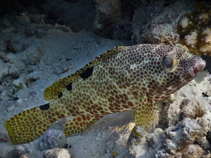| Family: |
Epinephelidae (Groupers) |
| Max. size: |
47.5 cm TL (male/unsexed); max.weight: 1,543.0 g |
| Environment: |
reef-associated; marine; depth range 0 - 30 m |
| Distribution: |
Indo-West-Pacific: East coast of Africa to the Line Islands. Except for its occurrence along the African coast (Zanzibar, Tanzania to Ponta Zavora, Mozambique) it seems to be primarily an insular species, occurring at most (probably all) of the islands of tropical Indian and west-central Pacific. Not known from the Red Sea, Persian Gulf, Sri Lanka, Philippines, Taiwan, Japan, or Australian waters (however, it is found at Rowley Shoals off Western Australia). |
| Diagnosis: |
Dorsal spines (total): 11-11; Dorsal soft rays (total): 14-16; Anal spines: 3-3; Anal soft rays: 8-8. Preopercle rounded, with a shallow notch; the serrae are enlarged but covered with skin; upper edge of the operculum almost straight. The head and body mostly covered with close-set dark brown, olive, or reddish brown spots. Those on the dorsolateral parts of the head, body, and on median fins polygonal and close-set, with the interspaces forming a white reticulum. Those on the ventral portions are more rounded, more separated and often more reddish. Three dark blotches are often visible at the base of the dorsal fin and one forming a saddle blotch on the caudal peduncle. These blotches differentiates it from E. merra and E. quoyanus (Ref. 5222). Small conspicuous dark spots on snout and sometimes between or below the eyes (Ref. 37816). |
| Biology: |
Occurs in lagoon patch reefs, the upper slopes of channels, and reef margins (Ref. 1602). Carnivorous (Ref. 81697). Nothing has been published on its biology. Solitary (Ref 90102). |
| IUCN Red List Status: |
Least Concern (LC); Date assessed: 06 November 2017 Ref. (130435)
|
| Threat to humans: |
harmless |
Source and more info: www.fishbase.org. For personal, classroom, and other internal use only. Not for publication.

